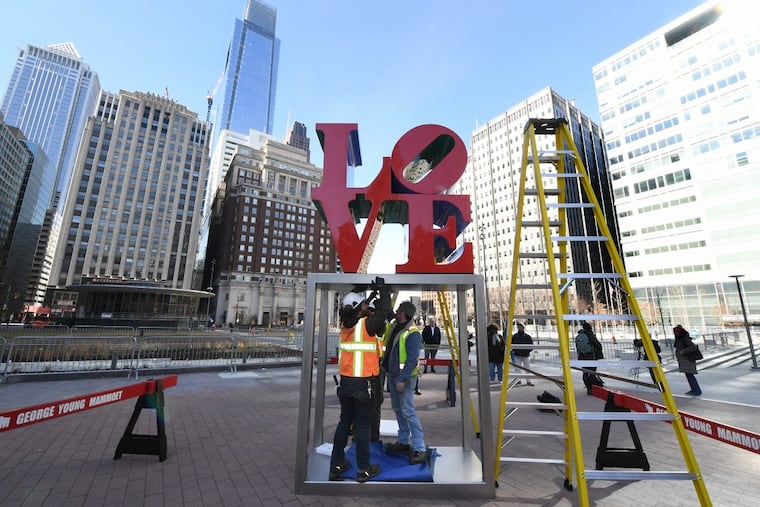New LOVE Park is graceless instead of gritty; is that the kind of Philly we want to live in? | Opinion
One can't avoid the sense that the park's emptiness is designed to discourage lingering and certain kinds of patrons. The stone benches look just comfortable enough to eat a quick food truck lunch. Grassy lawns that offer no cover will make it easier to spot and shoo away homeless people resting there. And, of course, there is no reference to or accommodation of skateboarders.

When Dilworth Plaza was transformed into Dilworth Park four years ago, a forsaken landscape suddenly became a thriving byway. While I might have wished for a less barren and stony look for the redesign, the park's popularity outweighed any aesthetic shortcomings.
Now LOVE Park, which underwent a renovation in 2016 to repair the parking lot beneath it, is on the verge of a grand reopening. But its trajectory, from vibrant to bleak, is the opposite of Dilworth's.
Despite its poor physical condition, LOVE was loved by a diverse cross-section of Philadelphians. Plan Philly's Ashley Hahn put it well : "LOVE Park may be tired, its granite slabs loose and clanky, but it works remarkably well as a truly public space. On any given day people play chess, snap photos, eat lunch, jaw with friends, soapbox, dance, read the paper, and just linger. Its diversity of casual use is a beautiful, rare thing." The park was also once so valuable to the skateboarding community, DC Shoes was willing to donate $1 million for its upkeep so long as skateboarding was permitted.
Now, the park exudes a desolation too pointed to ignore. Even after the trees are in bloom, the grass comes in and the fountain is turned on, those improvements won't entirely solve LOVE Park's problems.
Unlike the multi-tiered park of yore, the current LOVE Park is one graceless plane. As an open field, its best vistas are of ceaseless traffic on the park's borders. Though I was initially excited that LOVE would offer a clear diagonal path from one end to the other, I now sorely miss the elliptical landscaping that was the sculptural heart of the park. LOVE Park now functions like an enormous sidewalk, when its former design, with a round fountain and the round Welcome Center, signaled a retreat from the rectilinearity of downtown.
The new design ruins the much-needed distinction between park and city. The main thoroughfare now looks and feels like a sloping ramp in an airport. Previously, the fountain enticed you by forcing you to walk around it, and the LOVE statue somehow felt earned when you reached it crossing the park from west to east; now the fountain and statue are just selfie bait.
Speaking of selfies, take a look at those LOVE Park pictures from before and after the renovation. Before, a picture of the LOVE statue positioned tourist, sculpture, buildings on the Parkway, bucolic shrubs and a gushing fountain in one tight take. The LOVE sculpture sat on a trapezoidal pedestal and looked like the gem on a ring setting. The friction and exuberance of all these elements conveyed the sense of love — civic love, really — as much as the statue spelled it out.
Now, LOVE sits atop a bland square; people stand like passengers in an elevator car beneath the statue, mediocre architecture flanking them, a desert of pavers at their feet. It all adds up to a pretty bad picture.
While apparently not all the landscaping and street furniture have arrived, one can't avoid the sense that the park's emptiness is designed to discourage lingering and certain kinds of patrons. The stone benches look just comfortable enough to eat a quick food truck lunch. Grassy lawns that offer no cover will make it easier to spot and shoo away homeless people resting there. And, of course, there is no reference to or accommodation of skateboarders.
This raises the question of what kind of park we want and who we are building parks for. Yes, the old LOVE Park was dated, but its sculptural elements — boxy concrete tree containers and walls you could sit on, bollards you could lean on, and benches you could skateboard on — invited a human response. Instead of creating a park full of nooks where users can find the right place to steal a kiss or smoke a cigarette, the new LOVE Park is a sterile, corporate landscape.
Yes, corporate, because its intentional lack of landscaping will only seem active if it is commercialized. The sponsored, temporary programming that takes advantage of flat, flexible platforms like Dilworth Park is valuable, but it is also inorganic. Organic alternative uses — like skateboarding and busking — will instead be policed out of existence, because they do not fit into a prescribed set of uses for the park. Ironically, LOVE Park was once a place. Now as a non-place it will require tired place-making interventions, like movable furniture and festivals, to give it a sense of purpose.
Amid the new LOVE Park is another relic of its past: The Saucer. The mid-century Visitor Center now stands out like a beacon of authenticity and aesthetic daring. This building, which urban activist Jane Jacobs admired when she visited Philadelphia in 1962, reminds visitors that public spaces don't have to be mundane to be useful, vanilla to be popular.
It can also serve as a lesson that design isn't destiny. Just as skateboarders reimagined the old LOVE Park, we must make it our task to reimagine this landscape as something worthy of today's Philadelphia.
Diana Lind, managing director of Penn Fels Policy Research Initiative, is a board member of Philadelphia Citizen, where a version of this article was first published. dlind@sas.upenn.edu